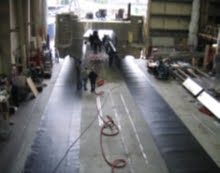Overlay Materials
Overlay materials are specially designed to provide durable, high-performance surface solutions across various industries. These materials are commonly used to enhance the strength, appearance, and functionality of existing surfaces in applications like flooring, countertops, walls, and industrial equipment. Whether for industrial, commercial, or residential use, overlay materials offer protection against wear and tear, improve aesthetics, and extend the lifespan of the underlying surface. Available in a range of textures, colors, and finishes, these materials provide a cost-effective way to upgrade and reinforce surfaces, ensuring both durability and style.
Overlay Materials Features
Capabilities: ![]() Easily covers small floor gaps, cracks and joints.
Easily covers small floor gaps, cracks and joints.![]() Easily rolls out over travel path to cover small floor gaps, cracks, and joints.
Easily rolls out over travel path to cover small floor gaps, cracks, and joints.![]() No danger of corrosion outdoors.
No danger of corrosion outdoors.![]() Roll out over long sections of porous surfaces without taping seams as with smaller sized sheets.
Roll out over long sections of porous surfaces without taping seams as with smaller sized sheets.

![]() Lighter and easier to handle than sheet metal.
Lighter and easier to handle than sheet metal.
On two 100’ long x 60” wide polyethylene roll-out overlays, this manufacturer moves a 100-ton catamaran ship hull out of the assembly plant.

| Specifications: | |
| Tested Properties: | Minimum Values: |
| Density, g/cm3 | 0.94 |
| Strength at Break, Ib/in-width (N/mm) | 243 (43) |
| Strength at Yield, Ib/in-width (N/mm) | 130 (23) |
| Elongation at Break, % G.L. 2.5 in (64 mm) | 560 |
| Elongation at Yield, % G.L. 1.3 in (33 mm) | 13 |
| Tear Resistance, Ib (N) ASTM D | 45 (200) |
| Puncture Resistance, Ib (N) FTMS 101, Method | 80 (356) |
| Carbon Black Content, %< | 2.0 |
| Environmental Stress Crack Resistance, hr | 1500 |
| Thickness, mils (mm) | 60 (1.5), other thicknesses available |
| Roll Length (approximate), ft (m) | 420 (128) |
| Low Temperature Brittleness, of (0C) | <-107 «-77) |
| Oxidative Induction Time, minutes | 100 |
